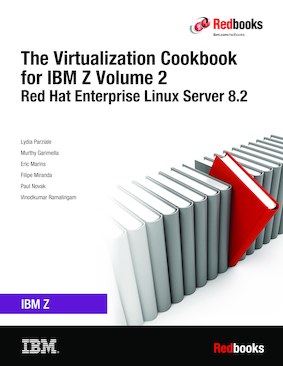
Published on 15 October 2021, updated 19 October 2021
Read in Google Books
Share this page:
ISBN-10: 0738460060
ISBN-13: 9780738460062
IBM Form #: SG24-8303-01
Authors: Lydia Parziale, Murthy Garimella, Eric Marins, Filipe Miranda, Paul Novak and Vinodkumar Ramalingam
Abstract
This IBM® Redbooks® publication is Volume 2 of a five-volume series of books entitled The Virtualization Cookbook for IBM Z®.
This volume includes the following chapters:
- Chapter 1, “Installing Red Hat Enterprise Linux on LNXADMIN” on page 3, describes how to install and configure Red Hat Enterprise Linux onto the Linux Administration server, which performs the cloning and other tasks.
- Chapter 2, “Automated Red Hat Enterprise Linux installations by using Kickstart” on page 37, describes how to use Red Hat’s kickstart tool to create Linux systems. This tool is fundamentally different from cloning in that an automated installation is implemented. You can try kickstart and cloning. Understand that these applications attempt to accomplish the same goal of quickly getting Linux systems up and running, and that you do not need to use both.
- Chapter 3, “Working with subscription-manager, yum, and DaNdiFied” on page 47, describes how the Red Hat Network works. It provides centralized management and provisioning for multiple Red Hat Enterprise Linux systems.
Kickstart is an easy and fast way to provision your Linux guests in any supported Linux platform. It re-creates the operating system from the beginning by using the kickstart profile configuration file that installs the new operating system unattended. It also sets up the new guest according to the definition that was set up in the kickstart file.
Usually, Linux is administered by the same team that manages Linux on all platforms. By using kickstart, you can create a basic profile that can be used in all supported platforms and customize Linux profiles, as needed.
Cloning requires a better understanding of the z/VM environment and z/VM skills. It is a fast process if you enable the IBM FlashCopy® feature in advance. It clones the disks from a golden image to new disks that are used by the new Linux guest. The process can be automated by using the cloning scripts that are supplied with this book.
It is recommended that you start with The Virtualization Cookbook for IBM Z Volume 1: IBM z/VM 7.2, SG24-8147 of this series because the IBM® z/VM hypervisor is the foundation (or base “layer”) for installing Linux on IBM Z.
Table of Contents
Part 1. Red Hat Enterprise Linux 8.2 servers
Chapter 1. Installing Red Hat Enterprise Linux on LNXADMIN
Chapter 2. Automated Red Hat Enterprise Linux installations by using Kickstart
Chapter 3. Working with subscription-manager, yum, and DaNdiFied
Chapter 4. Networking
Part 2. Other topics
Chapter 5. Working with disks
Chapter 6. Monitoring z/VM and Linux
Chapter 7. Configuring Linux for cloning
Chapter 8. Working with systemd
Chapter 9. Working with containers
Chapter 10. Security features
Chapter 11. Helpful information
Appendix A. Reference sheets, cheat sheets, and blank worksheets
Appendix B. Additional material